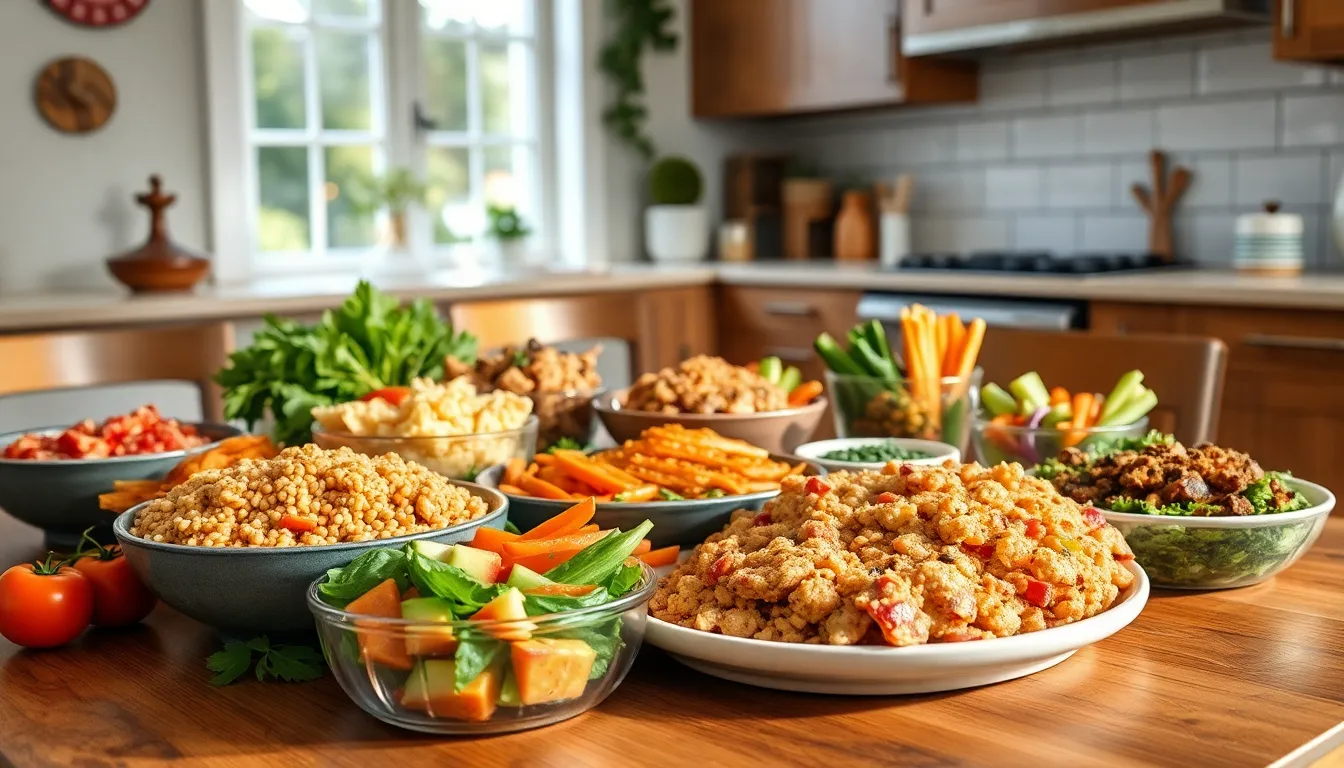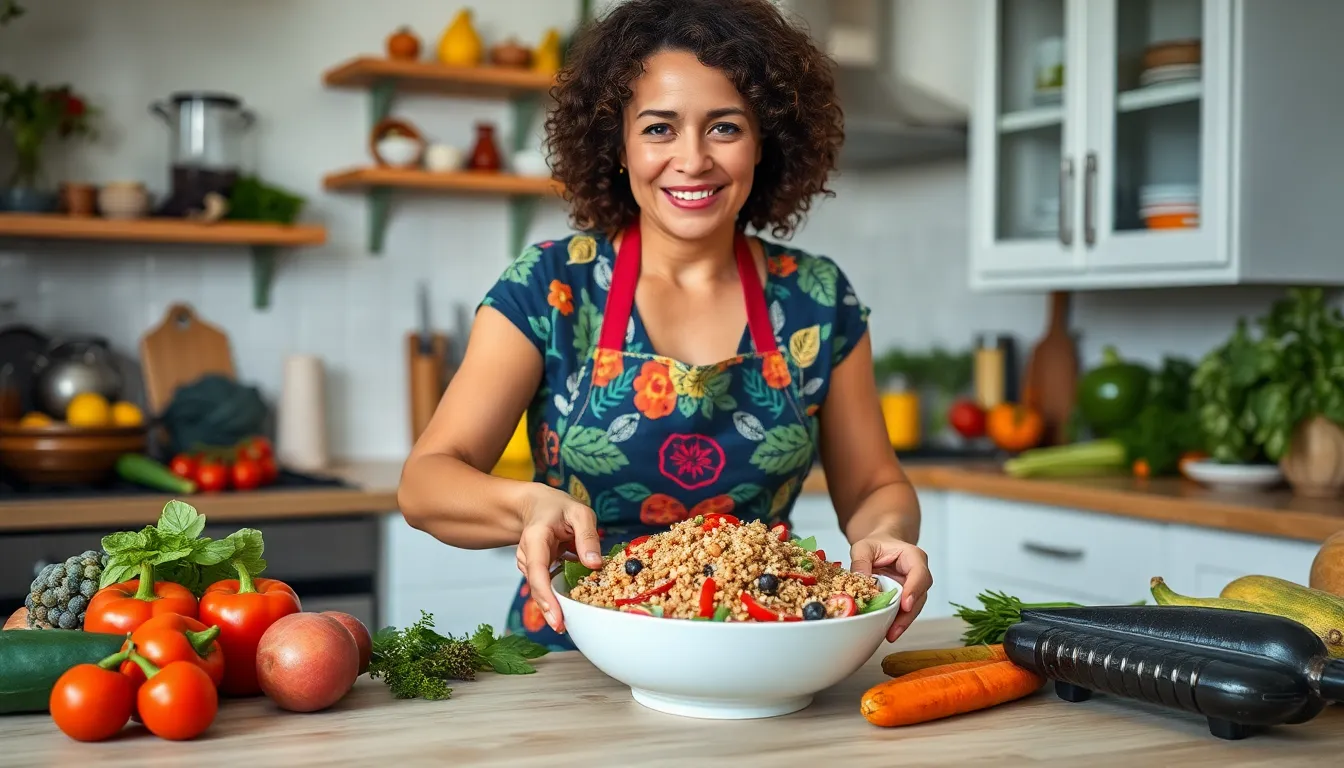Living with diabetes doesn’t mean sacrificing flavor or enjoyment at mealtime. With the right recipes, anyone can create delicious dishes that cater to dietary needs while still tantalizing the taste buds. The world of diabetic recipes offers a treasure trove of options, from hearty breakfasts to satisfying dinners and delightful desserts.
Exploring these recipes can empower individuals to take charge of their health without feeling deprived. By focusing on whole foods, balanced nutrients, and creative cooking methods, it’s possible to whip up meals that are both nutritious and enjoyable. Dive into the vibrant world of diabetic cooking and discover how easy it can be to maintain a healthy lifestyle while savoring every bite.
Table of Contents
ToggleOverview of Diabetic Recipes
Diabetic recipes emphasize balance and flavor without compromising health. Whole foods, low-glycemic ingredients, and nutrient-dense options dominate these recipes. Each dish aims to manage blood sugar effectively while satisfying palates.
Breakfast options include oatmeal topped with berries and Greek yogurt, or veggie omelets filled with spinach and tomatoes. Lunch ideas feature quinoa salads with cucumbers and chickpeas, or lean turkey wraps with avocado. Dinner could showcase baked salmon paired with asparagus or stir-fried tofu with a variety of colorful vegetables.
Snacks provide a chance to enjoy healthy choices like hummus with carrot sticks, or a handful of nuts mixed with seeds. Dessert recipes often focus on natural sweetness from fruits, such as chia seed pudding or baked apples with cinnamon.
Creative variations and substitutions allow for diverse meals that can cater to personal tastes while adhering to dietary guidelines. By exploring the vast array of diabetic-friendly recipes, individuals can find favorites that support their health goals and enhance their culinary experience.
Benefits of Diabetic Recipes

Diabetic recipes offer significant health benefits, ensuring that individuals with diabetes maintain a balanced diet while enjoying flavorful meals. These recipes focus on nutrition and support overall well-being.
Nutritional Advantages
Diabetic recipes emphasize whole foods, low-glycemic ingredients, and nutrient-dense options. These foods include:
- Whole grains: Foods like brown rice and quinoa provide fiber, which aids digestion and satiety.
- Lean proteins: Sources such as chicken, fish, and legumes support muscle maintenance and health without excessive fat.
- Healthy fats: Avocados, nuts, and olive oil supply essential fatty acids beneficial for heart health.
- Fruits and vegetables: Non-starchy options like leafy greens, berries, and bell peppers deliver vitamins, minerals, and antioxidants.
Balanced portions of these food groups contribute to better nutrition, reducing the risk of complications associated with diabetes.
Impact on Blood Sugar Levels
Diabetic recipes control blood sugar levels through careful ingredient selection and portion management. Benefits include:
- Low-glycemic ingredients: Foods like lentils and sweet potatoes release glucose more slowly, preventing spikes in blood sugar.
- Increased fiber content: High-fiber foods, such as chia seeds and oats, help stabilize blood glucose levels by slowing digestion.
- Balanced meals: Incorporating a mix of carbohydrates, proteins, and fats prevents rapid fluctuations in sugar levels, aiding in steady energy release.
These factors collectively contribute to improved blood sugar management, supporting a healthier lifestyle for individuals living with diabetes.
Types of Diabetic Recipes
Diabetic recipes encompass a range of meal options suitable for individuals managing blood sugar. These recipes include tasty and nutritious choices across all meal categories, ensuring balanced nutrition and flavor.
Breakfast Ideas
Breakfast options cater to both energy needs and blood sugar management.
- Oatmeal topped with berries and a dollop of Greek yogurt offers fiber and protein.
- Veggie omelets packed with spinach, peppers, and tomatoes provide essential vitamins and low-glycemic carbohydrates.
- Chia seed pudding made with almond milk and sweetened with a touch of stevia serves as a fiber-rich, satisfying start to the day.
Lunch Options
Lunch recipes support sustained energy and stable glucose levels.
- Quinoa salads loaded with colorful vegetables and a lemon-olive oil dressing are high in fiber and protein.
- Lean turkey wraps using whole wheat tortillas and an assortment of fresh veggies create a filling, nutrient-dense meal.
- Lentil soup, rich in protein and fiber, paired with a side salad offers warmth and nutrition.
Dinner Selections
Dinner selections focus on lean proteins and vibrant vegetables.
- Baked salmon with asparagus drizzled in olive oil delivers healthy fats and omega-3 fatty acids.
- Stir-fried tofu with a mix of broccoli, bell peppers, and snap peas showcases a low-calorie, high-nutrient dish.
- Zucchini noodles with marinara sauce and turkey meatballs present a low-carb alternative to traditional pasta meals.
Snack and Dessert Recipes
Snack and dessert options maintain health goals while satisfying cravings.
- Hummus served with carrot sticks provides a nutritious, satisfying snack.
- Greek yogurt with a sprinkle of cinnamon and a few almonds creates a protein-packed treat.
- Fruit salad featuring berries, melons, and a squeeze of lime highlights natural sweetness without added sugars.
Tips for Cooking Diabetic Recipes
- Choose Whole Ingredients: Opt for whole grains, fresh fruits, and vegetables. These foods contain essential nutrients and fiber, which help regulate blood sugar levels.
- Limit Added Sugars: Avoid recipes that incorporate high amounts of sugar. Instead, use natural sweeteners like stevia or small amounts of honey to enhance flavor.
- Incorporate Lean Proteins: Select lean meats, poultry, fish, legumes, and tofu. These proteins promote satiety without excessive saturated fat, beneficial for blood sugar control.
- Use Healthy Fats: Prefer healthy fats like olive oil, avocado, and nuts. These fats improve heart health while keeping meals satisfying.
- Monitor Portion Sizes: Serve smaller portions of carbohydrate-rich foods. This strategy helps manage blood sugar levels and prevents overeating.
- Experiment with Herbs and Spices: Enhance flavor naturally by using herbs and spices instead of salt. Options like garlic, ginger, and cinnamon impart zest without compromising health.
- Plan Balanced Meals: Each meal should include a mix of carbohydrates, proteins, and fats to maintain stable energy and glucose levels throughout the day.
- Read Labels: Always read nutrition labels on packaged foods. Look for products low in added sugars, refined carbs, and unhealthy fats.
- Prep Ahead: Prepare meals in advance to avoid impulse eating. Batch cooking and storing meals can help maintain healthy choices during busy days.
- Stay Hydrated: Drink plenty of water throughout the day. Staying hydrated supports overall health and can help manage hunger levels.
Implementing these tips can lead to flavorful and fulfilling meals that support diabetic dietary needs.
Embracing diabetic recipes opens up a world of culinary possibilities without compromising on taste. By focusing on nutritious whole foods and balanced meals, individuals can enjoy a diverse range of flavors while effectively managing their health. The journey of diabetic cooking encourages creativity and personalization, allowing everyone to discover their favorite dishes that support their dietary needs.
With the right ingredients and preparation techniques, maintaining a healthy lifestyle becomes not only achievable but also enjoyable. By integrating these delicious recipes into daily routines, individuals can take control of their health and savor every bite.




